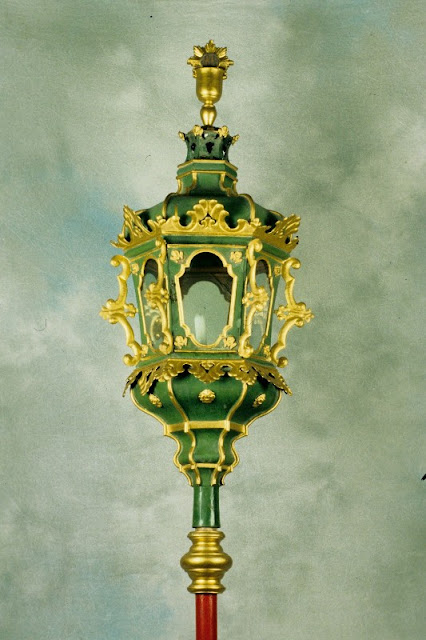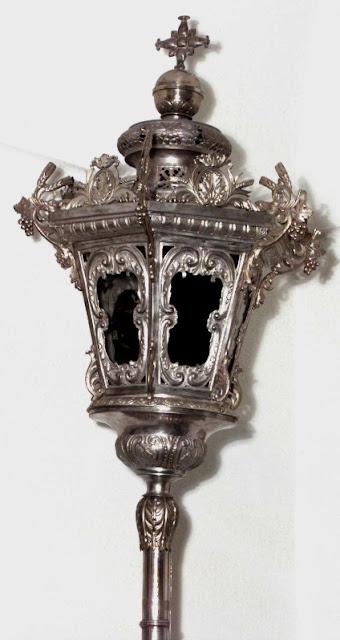Processional lanterns are essentially used akin to how acolytes carry lit candles in processions, at the gospel and so on. In the case of processional lampada, these are typically used at times like the consecration during the Mass, accompanying the Blessed Sacrament in processions such as at Corpus Christi, accompanying the Cross in processions and so on. In the image above, for example, we see two processional lanterns in use at Ss. Trinita in Rome which are accompanying the cross during devotions.
Contemporary processional lanterns, when they are seen at all, frequently look very plain, often simply a pole with a votive glass holder attached to that top that contains a tall glassed votive candle of the same sort that is placed in the vigil lamp that sits near the tabernacle.
However, traditionally the designs of processional lampada can be far more interesting and beautiful than this.
In terms of basic construction, there were two basic types that one might find. The first is of a fixed sort -- which is to say a lamp affixed in a fixed, stationary way on top of a pole. The second (which is the sort shown in the image above) saw the lamp having the ability to swivel, attached at the top in either side. The intent of this latter form was to allow the flame and the wax to better stay level (no matter what angle the pole was being held at) which helped to prevent the wax from spilling, being wasted, or even from the lamp flame being put out.
As already mentioned, contemporary processional lanterns tend to be rather more rare and also rather more plain in anture, but more ornate processional lampada are common in many parts of the world outside of the English speaking world -- where their relative absence likely has more to do with the timing of the rise of Catholicism in those regions, as well as its smaller size (which led to greater prevalence of Low Masses) than any other factor.
Today I thought we would take a look at some different processional lampada taken from the 18th, 19th and earlier 20th century to give a sense of some of the design potentialities and to introduce our readers to some of the more ornate forms. Perhaps in seeing these, some of you might be inspired to revive them in your parishes. One can see the nobility and solemnity that they can add to these rites.
 |
| 1775-1799 |
 |
| 18th century, Venice |
 |
| 1875-1899 |
 |
| 1800-1825 |
 |
| 1900-1925 |
 |
| 1775-1799 |
 |
| 1775-1799 |
 |
| 19th century |













